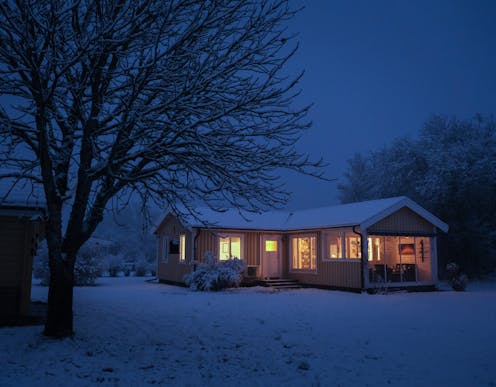Winter brings more than just ugly sweaters – here's how the season can affect your mind and behavior
Some of winter’s effects have been tied to cultural norms and practices, while others likely reflect our bodies’ innate biological responses to shorter days and colder weather.

What comes to mind when you think about winter? Snowflakes? Mittens? Reindeer? In much of the Northern Hemisphere, winter means colder temperatures, shorter days and year-end holidays.
Along with these changes, a growing body of research in psychology and related fields suggests that winter also brings some profound changes in how people think, feel and behave.
While it’s one thing to identify seasonal tendencies in the population, it’s much trickier to try to untangle why they exist. Some of winter’s effects have been tied to cultural norms and practices, while others likely reflect our bodies’ innate biological responses to changing meteorological and ecological conditions. The natural and cultural changes that come with winter often occur simultaneously, making it challenging to tease apart the causes underlying these seasonal swings.
With our colleagues Alexandra Wormley and Mark Schaller, we recently conducted an extensive survey of these findings.
Wintertime blues and a long winter’s nap
Do you find yourself feeling down in the winter months? You’re not alone. As the days grow shorter, the American Psychiatric Association estimates that about 5% of Americans will experience a form of depression known as seasonal affective disorder, or SAD.
People experiencing SAD tend to have feelings of hopelessness, decreased motivation to take part in activities they generally enjoy, and lethargy. Even those who don’t meet the clinical threshold for this disorder may see increases in anxiety and depressive symptoms; in fact, some estimates suggest more than 40% of Americans experience these symptoms to some degree in the winter months.
Scientists link SAD and more general increases in depression in the winter to decreased exposure to sunlight, which leads to lower levels of the neurotransmitter serotonin. Consistent with the idea that sunlight plays a key role, SAD tends to be more common in more northern regions of the world, like Scandinavia and Alaska, where the days are shortest and the winters longest.
Humans, special as we may be, are not unique in showing some of these seasonally linked changes. For instance, our primate relative the Rhesus macaque shows seasonal declines in mood.

Some scientists have noted that SAD shows many parallels to hibernation – the long snooze during which brown bears, ground squirrels and many other species turn down their metabolism and skip out on the worst of winter. Seasonal affective disorder may have its roots in adaptations that conserve energy at a time of year when food was typically scarce and when lower temperatures pose greater energetic demands on the body.
Winter is well known as a time of year when many people put on a few extra pounds. Research suggests that diets are at their worst, and waistlines at their largest, during the winter. In fact, a recent review of studies on this topic found that average weight gains around the holiday season are around 1 to 3 pounds (0.5 to 1.3 kilograms), though those who are overweight or obese tend to gain more.
There’s likely more going on with year-end weight gain than just overindulgence in abundant holiday treats. In our ancestral past, in many places, winter meant that food became more scarce. Wintertime reductions in exercise and increases in how much and what people eat may have been an evolutionary adaptation to this scarcity. If the ancestors who had these reactions to colder, winter environments were at an advantage, evolutionary processes would make sure the adaptations were passed on to their descendants, coded into our genes.
Sex, generosity and focus
Beyond these winter-related shifts in mood and waistlines, the season brings with it a number of other changes in how people think and interact with others.
One less discussed seasonal effect is that people seem to get friskier in the winter months. Researchers know this from analyses of condom sales, sexually transmitted disease rates and internet searches for pornography and prostitution, all of which show biannual cycles, peaking in the late summer and then in the winter months. Data on birth rates also shows that in the United States and other countries in the Northern Hemisphere, babies are more likely to be conceived in the winter months than at other times of the year.

Although this phenomenon is widely observed, the reason for its existence is unclear. Researchers have suggested many explanations, including health advantages for infants born in late summer, when food may historically have been more plentiful, changes in sex hormones altering libido, desires for intimacy motivated by the holiday season, and simply increased opportunities to engage in sex. However, changes in sexual opportunities are likely not the whole story, given that winter brings not just increased sexual behaviors, but greater desire and interest in sex as well.
Winter boosts more than sex drive. Studies find that during this time of year, people may have an easier time paying attention at school or work. Neuroscientists in Belgium found that performance on tasks measuring sustained attention was best during the wintertime. Research suggests that seasonal changes in levels of serotonin and dopamine driven by less exposure to daylight may help explain shifts in cognitive function during winter. Again, there are parallels with other animals – for instance, African striped mice navigate mazes better during winter.
And there may also be a kernel of truth to the idea of a generous Christmas spirit. In countries where the holiday is widely celebrated, rates of charitable giving tend to show a sizable increase around this time of year. And people become more generous tippers, leaving about 4% more for waitstaff during the holiday season. This tendency is likely not due to snowy surroundings or darker days, but instead a response to the altruistic values associated with winter holidays that encourage behaviors like generosity.
People change with the seasons
Like many other animals, we too are seasonal creatures. In the winter, people eat more, move less and mate more. You may feel a bit more glum, while also being kinder to others and having an easier time paying attention. As psychologists and other scientists research these kinds of seasonal effects, it may turn out that the ones we know about so far are only the tip of the iceberg.
Michael Varnum has received past grant funding from the National Science Foundation and the China Postdoctoral Science Foundation.
Ian Hohm does not work for, consult, own shares in or receive funding from any company or organization that would benefit from this article, and has disclosed no relevant affiliations beyond their academic appointment.
Read These Next
West Antarctica’s history of rapid melting foretells sudden shifts in continent’s ‘catastrophic’ geo
A picture of what West Antarctica looked like when its ice sheet melted in the past can offer insight…
From truce in the trenches to cocktails at the consulate: How Christmas diplomacy seeks to exploit s
World leaders like to talk up peace at Christmastime. But alongside the tales of seasonal breaks in…
As DOJ begins to release Epstein files, his many victims deserve more attention than the powerful me
Powerful men connected to Jeffrey Epstein are named, dissected and speculated about. The survivors,…






